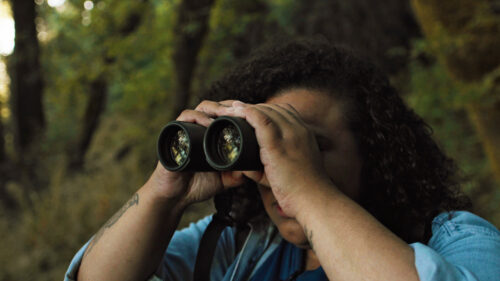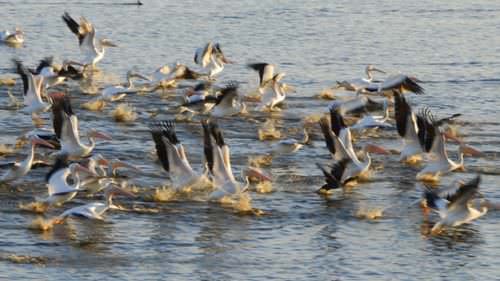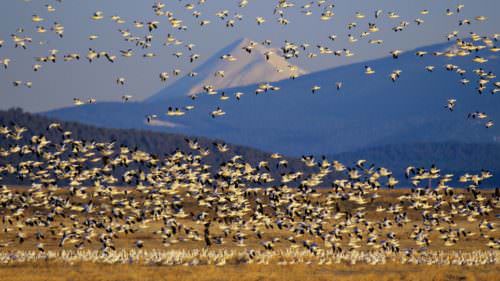Portland birder Sam DeJarnett remembers a turning point in her interest in birds several years ago when she noticed a group of brown pelicans gracefully gliding over the Pacific Ocean. They flew up above the water, scanning for fish, and she watched as each suddenly dove down headfirst into the water. It was a moment of clarity for her because she realized that the habitat could provide clues to identifying coastal birds. “There’s this whole world that opens up when you start to pay attention,” DeJarnett says.
Birds are everywhere on the Coast, often in large and vocal groups, which makes it a great place for beginning birders to learn, she adds. DeJarnett works to make birding and outdoor recreation more welcoming for all through her podcast and business, Always Be Birdin’. Watch her Instagram account for group walks and camping trips exclusively for BIPOC birders, including future outings to her favorite spots on the Coast.

Observing Coastal Birds in All Seasons
Coastal birds connect you to seasonal migrations, and knowing those yearly cycles will help you identify the birds, DeJarnett says. In spring and summer, an estimated 1.2 million seabirds nest in large, raucous colonies on Oregon’s numerous and protected sea stacks and islands. Come winter, the Coast’s large bays and estuaries, particularly in the north, are filled with ethereal loons, grebes, surf scoters, wigeons and little black and white bufflehead ducks.
“There’s no bad time to bird on the Coast,” says Sarah Swanson, a Portland birder and author of “Best Little Book of Birds: The Oregon Coast.” “We have all of these different groups of birds that are on different schedules, so there’s always something happening.”

Penguin-Like Puffins on the South Coast
Among DeJarnett’s favorite species to observe is the tufted puffin, a black, football-shaped bird with a thick orange bill and white eye mask. They spend fall and winter 50 miles out at sea, then travel to nest from April to September on several of Oregon’s massive sea stacks just offshore. “It’s a rare treat to see them nest,” DeJarnett says. Visitors can observe them at several beaches along the Coast, including Face Rock State Scenic Viewpoint in Bandon and Harris Beach State Park in Brookings.

Skittering Shorebirds on the North Coast
Puffin-lovers are in luck on the North Coast, too. At Cannon Beach, naturalist guides for the Haystack Rock Awareness Program often provide visitors with cool facts and a look through spotting scopes to observe these birds raise their young on the grassy, north-facing slopes.
Astoria is among DeJarnett’s favorite spots to see brown pelicans and cormorants, which congregate below the Astoria-Megler Bridge and dive deep for fish. Fort Stevens State Park, just west of Astoria, is great for spotting spring migrants such as the 10,000 Caspian terns that nest on East Sand Island in the Columbia River from April to September. On Jetty Lagoon in Fort Stevens, watch for shorebirds like dunlin, which can be seen in flocks of hundreds probing the mud along open shoreline. Small, gray and white sanderlings forage and run from waves in groups on sandy beaches all along the Coast from late July to April.

Nesting Birds on the Rocky Central Coast
South of Lincoln City, Boiler Bay State Scenic Viewpoint juts out into the ocean, making it a great birding spot, Swanson says. Look for common murres — which can be mistaken for penguins — pelicans and black oystercatchers, a resident coastal bird with a long tangerine bill.
Near Newport, Yaquina Head Outstanding Natural Area is another great spot for watching murres. You may also see peregrine falcons perched on cliffs, ornate harlequin ducks sheltered on rocks and bald eagles on the hunt. Brandt’s cormorants, with their elegant elongated necks and royal-blue throat patches, nest at Yaquina Head from May to September. Pigeon guillemots breed inland on Yaquina Bay from March to August.

Tips for Beginning Birders
- Bring binoculars or spotting scopes and an identification guide. Use a book or an app like the Cornell Lab of Ornithology’s free Merlin Bird ID or eBird, an online bird-observation database.
- To avoid disturbing birds, be quiet, move slowly and leave dogs at home. Be sure to stay behind fences and obey beach closures for nesting birds, including the federally threatened western snowy plovers.
- Consider joining an inclusive local group like the Portland-based Feminist Bird Club or BIRDHERS. Birding Oregon on Facebook is another great resource.
- Want to be more involved? Join the annual statewide Christmas Bird Count surveys, where you submit data about birds at various sites in Oregon in December and January.


